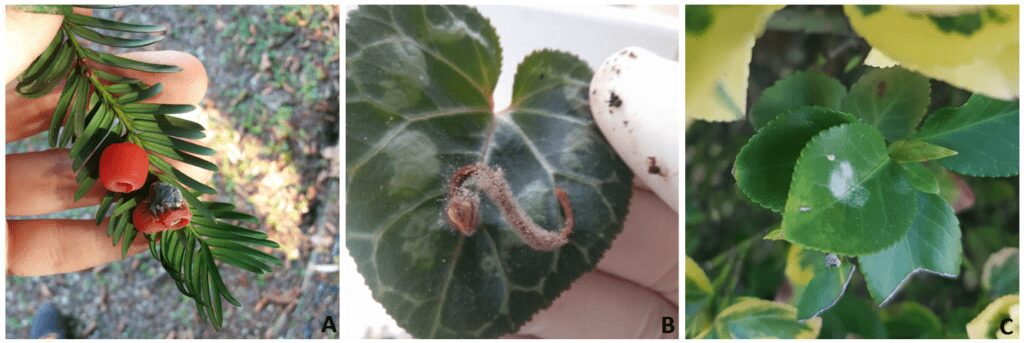Original article: La Fitopatologia: una scienza da scoprire, by Beatrice Cavenago
What is phytopathology?
Phytopathology, or plant pathology, is the science that studies plant diseases. More in detail, it deals with how they are triggered, the favorable or unfavorable conditions for their development, how they propagate, and the ways to eradicate or prevent them. The study of plant diseases and the organisms that cause them has been a puzzling subject for a long time and fundamental to be able to cope with pandemics and significant crop losses. Today, plant pathology is a course in the Agriculture’s faculties and represents a cardinal train for new sector professionals.
In phytopathology, the fundamental concepts are those of disease, symptom, and pathogen. Specifically, the disease is a “condition of persistent suffering, resulting from an alteration of the plant’s normal physiological processes.” It manifests itself through symptoms, which negatively affect the development and plant productivity. Pathogens – viruses, bacteria, fungi, phytoplasmas – cause these diseases, which infect a host plant’s tissue and manifest externally through symptoms. Of course, in this field, researchers also analyze the measures of fight and control of these diseases and preventive methods.
Phytopathology history
The first written works that manifest the diseases of plants come from Greek and Latin authors, who attributed its causes to some divinity’s wrath or astral malefic influences. First evolutions of these beliefs took place with the microscope’s invention in 1600, thanks to microorganisms observation. The firsts to use it efficiently were Marcello Malpighi – who observed micromycetes such as Penicillium – and Pier Antonio Micheli – who cultivated fungal species on a substrate. Later, in 1767, Fontana and Targoni Tozzetti spoke of the parasitic nature of wheat rust. A significant contribution is the “Saggio teorico sulle malattie delle piante” published in 1807 by Filippo Re.
In the following years, knowledge of plant diseases spread thanks to scientists as De Bary (who discovered the fungal nature of corn coal), Kühn (Fig. 1, “The diseases of cultivated plants, their causes and possibility of defense”), and Burrill (who discovered that bacteria could cause plant diseases). More complicated was the discovery and definition of viruses as phytopathogenic agents. Many scientists conducted several experiments in this area, but Beijerinck, in 1900, stated that “he was facing a new category of pathogens.” In 1935, Stanley defined the first characteristics of viruses after he managed to isolate them, and Kausche was able in 1939 to visualize the tobacco mosaic virus using the electronic microscope. Later, in 1967, Doi discovered the phytoplasmas – a kind of bacterial parasite – and Diener defined viroids – similar to viruses without protein coating – in 1972.
Since 1800, farmers knew the effectiveness of copper and sulfur compounds, but chemical companies’ definitively dismissed the use of organic products. Their excessive use is causing phenomena such as ecosystems’ imbalances and the selection of resistant strains, leading researchers to study alternative methods for plant defense, including integrated agriculture.

Phytopathologies’ fields
Phytopathology can be divided into more specific categories such as:
- Plant virology – it deals with diseases caused by viruses;
- Mycology – the study of fungi and, specifically, fungi that cause plant diseases;
- Phytobacteriology – it examines phytopathogenic bacteria and infections caused by them;
- Phytobiology – the study of the means and methods for the defense of plants from pathogens;
- Plant pathophysiology – it analyzes pathogen-plant relationships;
- Post-harvest pathology – it evaluates the alterations of the products already collected and at the time of storage;
- Forest pathology – the study of forest or shade plant diseases.
Types of plant diseases
Plant diseases can be divided into different types (Fig. 2) depending on the host-pathogen ratio:
- Trophic diseases – the pathogen thrive in substances present in the living cells of the plant (for example, the peronospores);
- Epiphytic diseases – the pathogen develops on the surface of the host plants establishing a close relationship, which cause problems in its processes, such as photosynthesis, respiration, and transpiration (for example, the “peacock eye” disease of the olive tree);
- Lithic diseases – diseases caused by the breakdown of the median lamella that holds the host tissue cells together (for example, the rottenness);
- Auxonic diseases – the pathogen alters the metabolism of the plans hormones bringing changes in the growth and development of the host (for example, the Agrobacterium tumefaciens);
- Hypnochereutical diseases – the pathogen decomposes the cellulose and lignin of the host (for example, the wood caries disease);
- Vascular diseases – the pathogen installs itself in the xylematic vessels of the host plant leading it to wither and desiccate (for example, Fusarium);
- Necrotic diseases – the pathogen kills the plant cells to nourish itself (for example, the bacterial fire disease)

Symptoms
The macro and microscopic manifestations of a specific pathology are the symptoms that appear on a host plant. It is essential to know them to have a picture of the phytopathy before making a more thorough analysis of the pathogen that determined it. The set of symptoms that define a specific disease is called symptomatological framework or syndrome. The disease manifests itself systematically – throughout the plant – or locally in a particular organ or part of the tissue. Symptoms may be changes in the plant shape or size – such as dwarfism or gall – or color changes – in the case of mosaic (Fig. 3). The third symptom type is a necrotic disease, which indicates groups of dead cells or whole sections of tissue. As in Plasmopara viticola, the symptoms have often been underestimated or used for ornamental purposes, as in the case of Tulip Breaking Virus.

Sources
- Belli G, Assante G, Bianco P. A, Casati P, Cortesi P, Faoro F, Iriti M, Saracchi M, Sardi P, Vercellesi A. (2012). Elementi di patologia vegetale. Piccin
- Lucas G.B., Campbell C.L., Lucas L.T. (1992), History of Plant Pathology. In: Introduction to Plant Diseases. Springer, Boston, MA
- www.ag.ndsu.edu
- www.agroscope.admin.ch
- www.apsnet.org
- www.britannica.com
- www.nda.agric.za